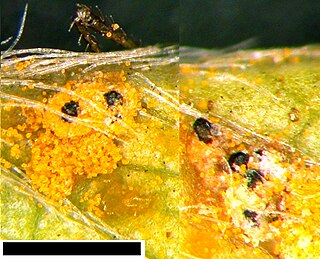
Pleosporaceae is a family of sac fungi. They are pathogenic to humans or saprobic on woody and dead herbaceous stems or leaves.

The Phaeosphaeriaceae are a family of fungi in the order Pleosporales. Species in the family have a cosmopolitan distribution, and are generally nectrotrophic or saprobic on a wide range of plants.
Paraphaeosphaeria is a genus of fungi in the Didymosphaeriaceae family. The genus has 23 species found in Europe and North America. Anamorph forms are found in the genus Paraconiothyrium. The genus was circumscribed by O.E. Eriksson in 1967.
Nodulosphaeria is a genus of fungi in the family Phaeosphaeriaceae.

Phaeosphaeria is a genus of fungi in the family Phaeosphaeriaceae. It has about 95 species. The genus was circumscribed by Japanese mycologist Ichiro Miyake in 1909, with Phaeosphaeria oryzae assigned as the type species.
Ophiosphaerella is a genus of fungi in the family Phaeosphaeriaceae. The genus was described by Italian-Argentinian botanist and mycologist Carlos Luigi Spegazzini in 1909.
Broomella is a genus of fungi in the family Sporocadaceae.

Lepteutypa is a genus of plant pathogens in the family Amphisphaeriaceae. First described by the Austrian mycologist Franz Petrak in 1923, the genus contains 10 species according to a 2008 estimate. It was increased to 15 in 2020.
Pestalosphaeria is a genus of fungi in the family Pestalotiopsidaceae.
Wettsteinina is a genus of fungi in the class Dothideomycetes. The type species Wettsteinina gigantospora was first described by Franz Xaver Rudolf von Höhnel in 1907. The relationship of this taxon to other taxa within the class was unknown in 2008, until it was resolved and placed in the Pleosporaceae family.
Comoclathris is a genus of fungi in the family Diademaceae.

Massarina is a genus of fungi in the Massarinaceae family. Anamorph forms of species in Massarina include Acrocalymma, Ceratophoma, and Tetraploa. Massarina was circumscribed by Pier Andrea Saccardo in 1883. The widespread genus contains about 100 species.

Pestalotiopsis is a genus of ascomycete fungi in the Sporocadaceae family.

Seiridium is a genus of plant pathogens in the family Sporocadaceae.

Monochaetia is a genus of fungi in the family Sporocadaceae. Species in the genus are typically plant parasites and saprobes, and cause leaf spot diseases on various hosts.

The Sporocadaceae are a family of fungi, that was formerly in the order Xylariales. It was placed in the Amphisphaeriales order in 2020.

Sporocadus is a genus of plant pathogens in the family Sporocadaceae.
Heterotruncatella is a genus of plant pathogens in the family Sporocadaceae.
Sarcostroma is a genus of fungi in the family Sporocadaceae. Most species of this genus are saprobes, endophytes or pathogens on leaves.








